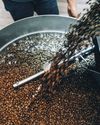If you want to fully appreciate tea’s delicate flavours, you need to know what you’re tasting – and you need to brew it right. Mike Riley offers a few professional pointers

Tea is endlessly fascinating in its tastes and variety, but our quest for convenience has caused us to commoditise its wonderful leaves and hide them away in paper teabags. It might even be said that we have lost touch with our national drink. But perhaps if we give it a little more care, attention and awareness, tea can follow speciality coffee’s meteoric rise of recent years.
My journey through the world of caffeine started three decades ago when I trained as a tea and coffee taster for a large commercial tea blender and coffee roaster in the north of England. While I spent most of those years focused on coffee, I never lost my love for tea and its range of alluring flavours, so I recently joined Storm Tea, a small family business dedicated to organic, fine and rare teas.
Taste enhancers
Tea’s wide-ranging flavours are brought about, in part, by the many variations in the way the leaves and buds of the evergreen shrubs Camellia sinensis and Camellia assamica are processed. Tea-producing countries such as China, Japan, Taiwan, India, Kenya and Rwanda all use differing techniques to preserve their tea leaves, which results in varying flavour profiles.
In simple terms, the fresh leaves are partly dried, which is known as “withering”, then rolled or twisted to release the juices and enzymes. The tea can then be further dried through a process known as “firing” to create white and green teas, after which the leaves are graded and packed.
Alternatively, the rolled or twisted green leaves can be exposed to varying degrees of oxidisation, when enzymes react with oxygen to change the colour and flavour of the tea. Black teas receive a prolonged oxidisation period before being fired, whereas oolong is only partly oxidised to create a tea that is somewhere between green and black.
This story is from the August - September 2017 edition of Caffeine.
Start your 7-day Magzter GOLD free trial to access thousands of curated premium stories, and 9,000+ magazines and newspapers.
Already a subscriber ? Sign In
This story is from the August - September 2017 edition of Caffeine.
Start your 7-day Magzter GOLD free trial to access thousands of curated premium stories, and 9,000+ magazines and newspapers.
Already a subscriber? Sign In

The Future Of Decaf?
A US company claims its pouch extracts caffeine without harming flavour

Great Coffee Shouldn't Cost The Earth
Caffeine’s editor-at-large Tim Ridley explains how to lower the environmental impact of your coffee-drinking habit

What The F**k...Is Honey Processing?
Apart from natural and washed coffees sits a whole other category, as Sierra Wen Xin Yeo explains

The grind
SEASONAL COFFEE

Tea with purpose
Michelle and Rob Comins explain how tea can be a force for good

Ten years on
We celebrate the London Coffee Festival’s first decade with a look at its successes

Chocolate and espresso pavlova with fennel roasted grapes
This year I’m giving coffee centre stage on the Christmas dessert table. I firmly believe coffee shouldn’t just be an afterthought to accompany dessert, it should be the dessert – but aside from that, it just makes sense.

Bitter Barista
Latte art competitions have been milking it for too long – they used to be fun, but now their focus on the wrong things is harming barista skills, says our cantankerous columnist

What The F**k ...Is The Maillard Reaction?
It’s just one of the elements you need to know about if you’re going to roast coffee successfully, as Edgaras Juška explains

Work Wonders
Coffee gets people through the working day. So it stands to reason that better coffee produces better work – and in some places the two are in perfect harmony, says Phil Wain